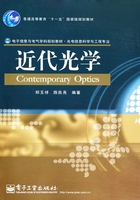
2.4 光在金属表面的反射和折射[2],[5],[20],[21]
2.4.1 金属中的透射光
假设电磁波在介电常数为ε、磁导率为μ、电导率为σ的各向同性介质中传播,根据麦克斯韦方程




式中,传导电流密度j和自由电荷密度ρ之间满足电流的连续性方程

由本构关系



将式(2.4-3)、式(2.4-5)代入式(2.4-1b)得
▽×H- =σE
=σE
对上式求散度得

即

故有

其解为

其中

τ称为弛豫时间。由此可见,自由电荷密度ρ随时间指数衰减。通常τ很短,对于金属约为10-1 8秒量级,因此金属中的自由电荷密度可认为始终为零,于是有

金属中的波动方程可表示为

对单色平面光波有

将上式代入式(2.4-12)得

引入复波数k~,令

再定义复介电常数ε~为

这样得到

它与介质对应的关系相似。同样,可引入复相速v~、复折射率n~,各自表示为


令

式中,κ称为衰减系数。取式(2.4-19)和式(2.4-20)的平方,得到


故


由式(2.4-23)和式(2.4-24)解得


引入复波矢 ,令
,令

式中, 为波矢的单位矢量,k'、k″均为实矢量。通常也将
为波矢的单位矢量,k'、k″均为实矢量。通常也将 定义为折射矢量N,即
定义为折射矢量N,即

利用复波矢 ,可以将金属中电场矢量的波动形式表示为
,可以将金属中电场矢量的波动形式表示为

式中, 为平面波的振幅,显然振幅沿k″方向衰减,因此也称k″为衰减常数;k'·r为
为平面波的振幅,显然振幅沿k″方向衰减,因此也称k″为衰减常数;k'·r为
相位传播因子,k'称为传播常数。k'决定平面波的等相面,而k″则决定等幅面。一般地,k'与k″的方向不同,因此等幅面与等相面不一致,说明金属中的透射波一般是非均匀波。
不妨先看一个简单的情况,即单色平面光波垂直于金属表面传播,假设金属表面为xy平面(z=0),光波沿z轴在金属中传播,此时,k'与k″都沿z轴方向,式(2.4-29)可写为

其中,k'、k″分别为


对于良导体,σ/(εω)≫1,则有

根据式(2.4-30),在z=z0=1/k″处,振幅降为表面处振幅的e-1,z0称为穿透深度,其值为

可见,穿透深度与光波频率及导体的电导率的平方根成反比。以铜为例,其电导率约为5.9× 107/(Ω·m),对于可见光,穿透深度约为数纳米。
将式(2.4-30)代入麦克斯韦方程组可以得到

式中, ^为表面法线方向的单位矢量,注意不要与折射率混淆。对于良导体,将式(2.4-33)代入式(2.4-35)可得
^为表面法线方向的单位矢量,注意不要与折射率混淆。对于良导体,将式(2.4-33)代入式(2.4-35)可得

可见,磁场的相位比电场的相位落后π/4。并且

即

而在介质中,有

这说明相对于介质,在金属中电磁波的磁场的作用比电场的作用要大。
下面来讨论一个普遍的例子。假设介质1是空气,介质2是金属,将金属的复折射率 写为
写为

由斯内尔定律

因为 为复数,因此
为复数,因此 也是复数;显然
也是复数;显然 不再有折射角的简单几何意义。在可见光范围内,金属反射不再满足布儒斯特定律。下面讨论光在金属中的实际折射角。设入射面为xz平面,金属中光波相位的空间变化为
不再有折射角的简单几何意义。在可见光范围内,金属反射不再满足布儒斯特定律。下面讨论光在金属中的实际折射角。设入射面为xz平面,金属中光波相位的空间变化为 ·r,其中
·r,其中 可表示为
可表示为

由式(2.4-41)和式(2.4-42),可得


为运算方便起见,令

式中,q和γ都是实数。经过计算,得到


于是得到相位的空间变化为

将上式代入式(2.4-29),可以得到等幅面方程为

即z为常数的平面。同样也得到等相面方程为

可见,等相面为平面,设该平面的法线与界面法线的夹角为 ,则
,则


则由上式可以得到,光从空气入射到金属中实数形式的折射定律为

其中 为光在金属中真实折射角
为光在金属中真实折射角 为金属的实折射率,即
为金属的实折射率,即

显然 与入射角θ1有关。
与入射角θ1有关。
2.4.2 金属界面的反射光
假设光从折射率为n1的介质入射到折射率为 =n(1+iκ)的金属表面,则反射光仍然在介质中,故反射光还是均匀波。s光和p光的振幅反射率分别为
=n(1+iκ)的金属表面,则反射光仍然在介质中,故反射光还是均匀波。s光和p光的振幅反射率分别为


由斯内尔定律和三角函数关系可得

令

则由式(2.4-53a)和式(2.4-53b)可得


s光和p光的光强反射率分别为


令δ=δs-δp,由式(2.4-44)可得,当θ1从0°到90°时,δ从180°降到0°;其中,当θ1=θP时,δ=90°,θP称为主入射角,类似于布儒斯特角。当入射角为主入射角时,RP有极小值,但不为零,故光在金属表面的反射不符合布儒斯特定律。相应地引入主方位角ΨP,定义为

可以证明[2],金属的光学常数n、κ与主入射角θP及主方位角ΨP近似满足


因此,通过对主方位角ΨP和主入射角θP的测量,可以获得金属的光学常数。